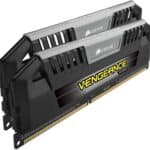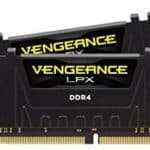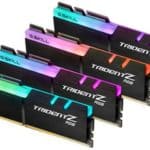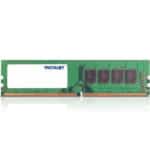Best DDR4 RAM In 2022
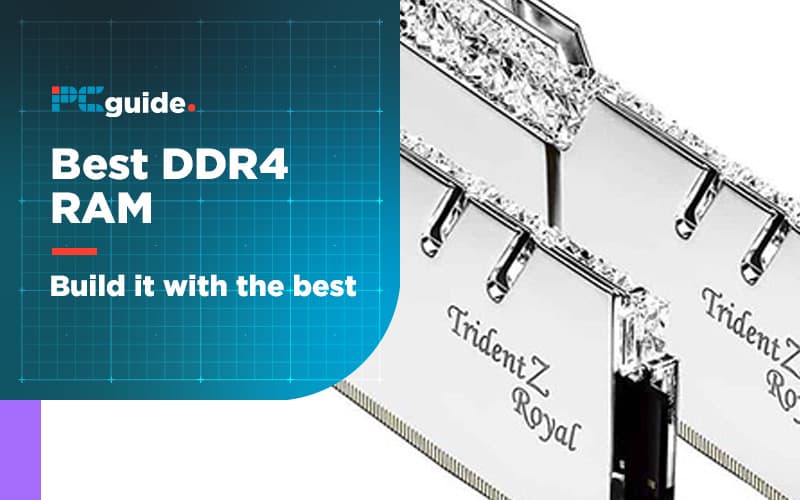
Buying DDR4 RAM for gaming may not always look easy, but don’t worry: we have you covered. Whether you’re trying to find the fastest RAM on the market, RGB RAM to complete your build’s lighting or even the best RAM for the money, we got you covered.
Below, we’ve provided seven options to choose from. Each of these options comes from reputable manufacturers, and any one of them could be the best RAM… depending on your needs, of course. If you aren’t certain how to decipher specs or what they actually mean, we’ve also included a buying guide at the bottom of the article explaining everything you need to know.
Enough of the setup, though. You want the best RAM for gaming – let’s hop into the options when it comes to both an RGB kit and RAM with a little less bling..
Products at a Glance
Best DDR4 RAM In 2022
- Great capacity, good speed
- The best RGB solution, hands-down
- Pricey
(Image credit Corsair)
The Corsair Vengeance RGB Pro kit is for one type of user: the RGB fanatic.
If you want a fully-synchronized RGB build for your entire system, then Corsair’s peripherals and components are simply the way to go. Their RGB implementation is the best in the industry, and this Corsair RGB RAM kit is as good as it gets. You have high quality, great aesthetics (there’s also a nice white version, but it is slightly more expensive), highly-customizable RGB effects… but that comes at a price, as most things do.
For one, this RAM kit is only rated for 2666 MHz at stock. While you should be able to overclock it a bit, this is still kinda low for the $100+ you’ll be paying. You can opt for a higher-speed kit in configuration, but these all increase the price of the Corsair Vengeance RGB Pro kit, especially when compared to non-RGB RAM sticks running at the same speeds.
They are readily available though and super-reliable. Oh and did we mention how great it looks. That’s why it is up there with the best ram out there, not to mention the most popular 16GB kit on the market today.
- Great capacity
- Stellar speeds
- Highly variable pricing and availability
(Image credit Corsair)
Before Corsair was known for RGB, they were also known for high-performance RAM and peripherals. The Corsair Vengeance LPX 16GB kit demonstrates why, boasting dual 8GB sticks running at a whopping 4600 MHz. This is one of the fastest RAM sticks you’ll find on the market, and is honestly faster than some motherboards can even keep up with.
However.
There are two massive problems here.
For one…when this RAM is available, it’s expensive. Really expensive. Starts at $500 expensive.
But also…pricing and availability alike are both highly variable. This is a problem for all top-of-the-line RAM, unfortunately, and it is unlikely to change anytime soon. We recommend actively comparing this RAM kit and our next one, and grabbing whichever is cheaper when you read because that is very likely to change.
If you can grab this 16GB DDR4 kit, grab it quick smart.
- Great performance
- Good looking desin
- More understated RGB
- G.Skill can be expensive
(Image credit G.Skill)
Our pick for best overall DDR4 RAM kit is the G.Skill Trident Z RGB. This kit is rated to run its dual 8GB sticks at 4400 MHz. Additionally, you have some strong RGB lighting and a decently-thick heatsink, which should ensure that this RAM stays cool despite the high speeds it’s running at. It’s a great RG kit.
If you don’t want to compromise on anything, this is the best ram for gaming, no question. Aesthetics, performance– everything you could want is here.
However… here’s where we find the catch again. This kit is extremely expensive– retailing for right around $400 at the time of writing for a kit with 16GB capacity (2 x 8GB) . This kit also has highly variable pricing and availability, which means that its pricing changes a lot and it even being available to purchase also changes a lot.
If the Trident Z RGB kit is available and cheaper than the Corsair options listed above, we say go for it– otherwise consider the Corsair option, or configuring one of the cheaper RAM kits with a higher clock speed.
- Superb speed
- Well-suited for Ryzen 7 and Threadripper builds
- Low CAS latency
- High end ram, high end price
(Image credit Patriot)
The Patriot Viper Steel Series is a favorite among enthusiasts, and this is actually our first truly high-end selection. There’s a capacity 16GB of RAM here for roughly ~$150, but cutting that price in half, you’d still be getting 8GB of incredibly fast, low-latency RAM for only $75.
While the 4133 MHz rate on the Patriot Viper is likely beyond what you could reach with a Ryzen processor, this means it’s more or less guaranteed to run well in the ~3600 MHz range that AMD Ryzen is known to reach, and it has a lower CAS latency.
The price is a bit of a bitter pill for the Viper Steel, but it’s more than fair for what you’re getting in return which is some of the best RAM out there in this 16gb kit..
- Will certainly stand out in your build
- Great CAS latency for speed
- Great reputation for Ryzen CPUs
- Expensive
- Probably looks ridiculous
(Image credit G.Skill)
The is the ram that any rapper building his own PC would go for. Without a doubt. We have picked the silver version here, but yes it also comes in gold (google it!)
The G.Skill TridentZ series is a particular favorite among Ryzen enthusiasts, since they have a higher chance of using Samsung B-Dies. (We’ll explain why this matters in the buying guide below.)
Even without that, though, these TridentZ RAM sticks with their 16GB capacity are rated to reach up to 3200 MHz, good for any Ryzen build, but especially good for a Ryzen APU build. Set aside 2GB or so for the iGPU and you’ll be in business for a surprisingly strong 1080p gaming experience, even with some modern AAA games.
The CAS Latency is well-balanced with the 3200 MHz speed here, so that shouldn’t cause any problems, either.
If you are the kind of hobbyist that likes their builds to match beautifully though, good luck finding a GPU and mobo to match with this 16GB kit!
How To Find The Best DDR4 RAM
In this section, we’re going to answer any questions you might have about DDR4 RAM, its specs, and what you need to know before buying it. If you still have any questions left after reading this section, feel free to leave a comment below the article and we’ll get back to you as soon as possible.
What Is DDR4 RAM?
DDR4 RAM is the successor standard to DDR3 RAM, which is the successor to DDR2, and so on. The naming scheme is fairly logical here, fortunately.
DDR4 RAM usually comes in one of two form factors: DIMMs and soDIMMs. DIMMs are the main desktop form factor (and the only one covered in this article), while soDIMMs are much smaller and used for laptop RAM upgrades. Either DIMM is an individual memory unit, and all of the RAM kits we’ve included in this article have 2 DIMMs. We’ll explain why in a little bit.
What Is XMP/AMP?
The XMP profile and AMP profile are standards for running RAM at higher clock speeds. They offer pre-defined profiles for easy RAM overclocking, which is ideal for users who aren’t ready to do it themselves.
We generally recommend this approach to achieving the most speed out of your RAM, since doing your own overclocking is a process involving extensive trial-and-error. Even if you plan on doing your own OCs, XMP/AMP profiles can show you good starting points.
In higher-end RAM kits, both of these profiles are generally included. Despite XMP being Intel and AMP being AMD, there is no known performance difference and– generally speaking– both will be compatible with your platform of choice. In other words, if you’re looking for the best DDR4 RAM for your Ryzen or Intel CPU, just choose good RAM.
What does Single-Channel, Dual-Channel, And Quad-Channel mean?
“Channel” refers to how many DIMMs are running in synchronization with each other and has a great impact on speed. Below, we’ve listed common channel configurations and their impact on performance.
Note: To run RAM in multi-channel configurations, every DIMM needs to match in speed, capacity, and (ideally) brand.
- Single-Channel – A single RAM stick. This will achieve only half of its rated speed, and serve to bottleneck the CPU.
- Dual-Channel – Two RAM sticks. These will reach their rated speeds, and serve a literal 2x performance improvement over SC setups.
- Quad-Channel – Four RAM sticks. These will reach their rated speeds and do offer more performance than Dual-Channel, but these gains are fairly marginal and won’t be seen in most games/applications.
If you look through our article, you’ll notice that every kit we recommend is a dual-channel RAM kit. That isn’t a coincidence– the only reason to buy a single RAM stick is if it’s to upgrade from a single-channel setup. Otherwise– dual-channel or better, only.
How Does RAM Speed Affect Performance?
Here’s the thing about gaming RAM: if you only look at average FPS, you probably aren’t going to see a difference. If there is one, it will be incredibly marginal… or you upgraded to a dual-channel setup from a single-channel one. (Really, guys: don’t do single-channel, ever.)
In any case, RAM speed is one of those specs that people love to tout around but few actually understand. We’re going to do our best to demystify it now.
Since DDR4 RAM emerged into the mainstream, higher RAM speeds have become the standard. DDR4’s starting speed of 2400 MHz is higher than DDR3’s peak speed of 2133 MHz, and since RAM is usually sold at its minimum spec…
Most users experienced a 2x RAM speed increase moving from DDR3 to DDR4 RAM platforms.
This difference was felt in a slight FPS boost by most gamers, but otherwise didn’t seem to matter to non-professional users.
What many don’t realize is that RAM speed actually impacts minimum FPS, not maximum or average. In other words, faster RAM speed will improve your gaming experience by reducing the severity of FPS drops– in some cases, to the point where your display’s refresh rate is still beneath your FPS drop. This is ideal for gamers who want a completely smooth gaming experience.
How Much RAM Do I Need?
RAM capacity is another hot topic, with many consumers and OEMs stuffing as much RAM as possible into their machines. This has reached a point where high-end gaming laptops (with midrange PC performance) are toting around a whopping 16 GB of DDR4 RAM, dramatically raising prices.
Spoiler alert: this usually isn’t necessary.
- 8 GB RAM – The minimum spec recommended for gamers and common consumers. While Chrome will massacre this pool if you let it, this should be more than enough for gaming and common multitasking.
- 16 GB RAM – This is recommended primarily for professionals and streamers, who need the extra RAM to work with. Unless your multitasking needs are particularly severe, this is unnecessary for a pure gaming rig.
- 32 GB RAM – This is for career professionals and streamers, using applications, VMs, etc that require a RAM pool this large. This is well beyond any level of practicality for a gaming PC.
- 64 GB RAM – Stop. (Unless you’re running a server– in that case, this should work.)
Do Heatsinks And RGB Make A Difference?
Heatsinks
If you’re overclocking, heatsinks (heat spreaders) make a difference. Otherwise, no– RAM doesn’t generate much heat at all, and letting it run naked shouldn’t come with any significant penalty to speak of.
RGB
RGB lighting doesn’t make a performance difference when you are looking for the best RGB RAM, but it does look pretty. And really, isn’t that the biggest difference between them all?
Our Verdict
These Corsair sticks are a favorite here at PCGuide simply because they look great, perform well, and are reliable – plus they are easy to get hold of from almost anywhere. When paired up with Corsair’s iCue software they can add pulsating color to any build and make things pop. IN terms of performance, well it’s as you would expect from a major manufacturer like Corsair. Nigh on perfect. Recommended.

